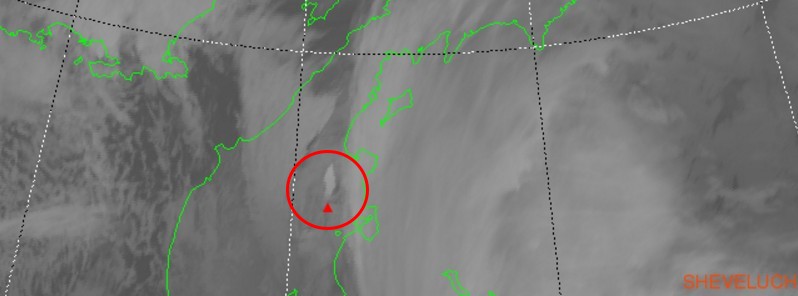Sheveluch erupts ash 11 km (36 000 feet) a.s.l., Russia

Russia's Sheveluch, one of the biggest volcanic structures in Kamchatka, erupted at 21:50 UTC on December 9, 2016, sending ash up to 11 km (36 000 feet) above sea level. The aviation color code was briefly raised to Red.
According to KVERT VONA released 23:55 UTC last night, satellite data shows explosions at Sheveluch sent ash up to 10 – 11 km a.s.l. An edge of ash cloud was about 106 km (66 miles) NNE from the volcano at 22:06 UTC.
"Explosive-extrusive eruption of the volcano continues and ash explosions up to 10 – 12 km (32 800 – 39 400 feet) a.s.l. could occur at any time. Ongoing activity could affect international and low-flying aircraft," the observatory warned.
At 01:05 UTC on December 10, an edge of ash cloud was about 320 km (199 miles) N of the summit. By 03:01 UTC, the distance of ash cloud was reaching 910 km (565 miles) NNE from the summit and was as high as 11 km (36 000 feet).
Credit: JMA
Credit: KVERT
At 05:38 UTC, the observatory reported the strong explosive event at the volcano has finished and that it has lowered the aviation color code to Orange. According to satellite data, a thermal anomaly is observed over the volcano, but no ash is erupting from the volcano at this time.
According to the local emergencies authorities, there are no settlements in the path of the ash plume and no Kamchatka residents were affected by the incident.
Geological summary
The high, isolated massif of Sheveluch volcano (also spelled Shiveluch) rises above the lowlands NNE of the Kliuchevskaya volcano group. The 1300 cu km (311.9 cu miles) volcano is one of Kamchatka's largest and most active volcanic structures. The summit of roughly 65 000-year-old Stary Shiveluch is truncated by a broad 9-km-wide late-Pleistocene (5.6 miles) caldera breached to the south. Many lava domes dot its outer flanks. The Molodoy Shiveluch lava-dome complex was constructed during the Holocene within the large horseshoe-shaped caldera; Holocene lava dome extrusion also took place on the flanks of Stary Shiveluch.
At least 60 large eruptions have occurred during the Holocene, making it the most vigorous andesitic volcano of the Kuril-Kamchatka arc. Widespread tephra layers from these eruptions have provided valuable time markers for dating volcanic events in Kamchatka. Frequent collapses of dome complexes, most recently in 1964, have produced debris avalanches whose deposits cover much of the floor of the breached caldera. (GVP)
Featured image credit: JMA

Getting closer. Are either or both Mt Baker and Mt Rainer next? It is inevitable except for the dates.